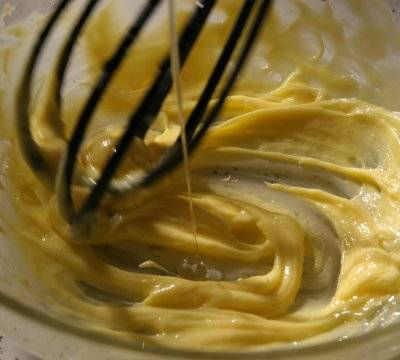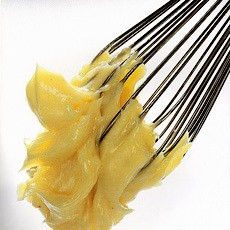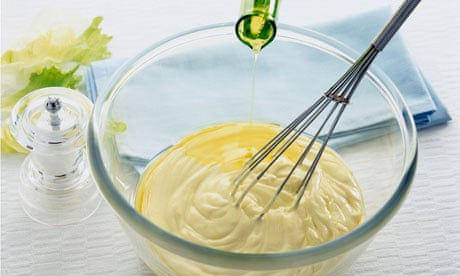The miracle of mayonnaise
- rosemarydearman1
- Feb 3, 2020
- 6 min read

"real mayonnaise is much easier than most of us realise. The only skill you really need is patience"
Felicity Cloake
I don't make mayonnaise very often, but I did yesterday for the coleslaw, and yet again I was blown away by the magic of it. And it took no more than 5 minutes I swear. Moreover it's easy - really it is - only once has it curdled on me, and this is easy to fix by starting with another egg yolk and beating your curdled mix into it.
What I find so amazing is that you start out with these two rather different things - an egg yolk and some oil - and you end up with something completely unlike either. It's completely magical how the yolk transforms into this creamy, shiny mass. And it always makes me ask the same question - how on earth did somebody think of trying this out way back when?
"And oil's not supposed to mix with water. But then someone invented mayonnaise, and wham - instant mixing." Jackie Morse Kessler
Because that's what mayonnaise is really - oil and water - the egg yolk being mostly water.
Until today I confess I thought that it had been invented in the eighteenth century - a time of enormous culinary invention it is becoming increasingly clear to me. But no, it was simply that in the eighteenth century the French discovered it and made it their own. For actually it is Spanish - maybe even more specifically from the Balearic Island of Menorca. They seem to think that similar sauces were made as far back as the 14th century. The Spanish called it aioli bo (the bo means no garlic, the aioli is garlic and oil). And of course aioli is a very garlicky mayonnaise made in Provence. In 1756 the French invaded Menorca which is when they discovered it and took it back to France where it became known as mayonnaise. Nobody really seems to know why although there are all sorts of stories - virtually all of them discredited, so I won't even mention them.

I'm cheating a bit with this post because I did a mini treatise on mayonnaise in one of the cookbooks I made for my children. But to be fair I have also looked online for a bit more information. Here is a passage from Elizabeth David that I quoted back then, that sort of sums up how I feel about mayonnaise.
“it is one of the best and most useful sauces in existence, but because it is not cooked at all, the making of it seems to represent to the uninitiated something in the nature of magic, or at least of a successful conjuring trick. ... a beautiful thick mayonnaise can be produced from the liquidizer in a matter of a minute or two. But although I regard this machine with the utmost gratitude, since it is a mechanical kitchen-maid rather than a gadget, I do not care, unless I am in a great hurry, to let it deprive me of the pleasure and satisfaction to be obtained from sitting down quietly with bowl and spoon, eggs and oil, to the peaceful kitchen task of concocting the beautiful shining golden ointment which is mayonnaise.” Elizabeth David
But it's not her recipe that I use. Mine is from Simone Beck in Simca's Cuisine, and I may have given it to you before. But just in case I didn't mention it when I did her book recently, here it is.
Mayonnaise classique à ma façon (classic mayonnaise my way)
2 egg yolks 1 tbs Dijon mustard (I use wholegrain) 3/4-11/2 cups oil (I use olive oil) 1-2 tbs wine vinegar, lemon juice or water Salt Black pepper 1 1/2 tbs fresh chives, chervil and parsley, minced (optional)
Put the egg yolks and mustard in a warm bowl and mix with a whisk. Then put the bowl over boiling water and continue to beat for 8 or 9 seconds to lightly poach the egg yolks with the mustard; you will find a slight difference in the compostion - it will be smooth and a little sticky.
Remove from the steam and beat in the oil, first a teaspoonful at a time. When the mixture becomes creamy, add more oil, a little at a time, until you have used about 3/4 cup oil and you can see that the mayonnaise is saturated. It is then necessary to give it the capacity to absorb more oil; add 1 1/2 to 2 tablespoons of boiling vinegar, lemon juice or water. When you see the mayonnaise become clearer and creamier, add the remaining oil, beating constantly. Then season well with salt, pepper, and, if you wish, the herbs.
There are two things about this recipe that I have not seen in others. First that she whisks the egg yolk with the mustard before adding the oil over hot water. Though I did see somebody else mention another recipe that beat the egg first. Not over hot water though. Honestly I suppose it's a bit precious, but really not at all difficult - it takes literally seconds.
The other thing is the addition of that boiled lemon juice or vinegar. I use lemon juice. Again a bit precious but I have to say that it works. I do it in a very old Turkish coffee metal jug because one tablespoon or even two is really not a lot of lemon juice. She describes it as her 'truc' or 'trick', so I recommend it. And again it only takes seconds. Now yesterday I only made half the quantities she gives, and honestly it took less than five minutes and really is not that hard on the elbow grease. I just did it by hand with an old-fashioned balloon whisk.
I guess the only major question you will see discussed is what kind of oil. This ranges from the olive oil adherents like Elizabeth David:
“Groundnut oil makes quite passable mayonnaise and could certainly be used for practising but, as it is absolutely devoid of taste, it is necessary to add flavour in the form of a little extra lemon juice and perhaps mustard.”
Then there are those who. think that olive oil is too strong and bitter a taste. These include Delia who also has a version using a food processor and Felicity Cloake who has done her usual comprehensive survey of the subject. The general opinion seems to be to go for something milder - sunflower or rapeseed (I think that's canola) or a mild olive oil. I used an almost half and half mixture yesterday and yes, I do think it was better than pure olive oil - not quite as bitter. It's a subjective taste thing really.
So why don't people make their own? Is it because there is perfectly acceptable mayonnaise out there in the supermarkets? Well lots of the chefs seem to say that yes they are Ok sometimes. But as Felicity Cloake points out - the label on her own chosen store-bought version from a 'reputable' supermarket - probably Waitrose I am guessing - has at least ten ingredients in it, whilst mayonnaise really only has two - three if you count the lemon juice or vinegar. The general opinion from them all seems to be the same as Hugh Fearnley-Whittingstall:
"I've got plenty of time for ready-made mayo – I keep a decent organic variety in my fridge, which I dispense freely for greedy sandwiches and impromptu sauces – but the homemade stuff is something else altogether. Try a batch and you'll see that you've made not just something better, but also something utterly different." Hugh Fearnley-Whittingstall
And I have to say, having just picked up the latest Coles Magazine, which is full of what to put in kids' lunch boxes - shop-bought mayonnaise features quite a bit. Just make sure you get a whole egg version. Check out the ingredients. But no don't. Just make your own. Although it will only keep for a couple of days.
Somebody really ought to push making your own mayonnaise. Though I have to say I don't think I even saw my French hostesses making it. I bet Madame Perruque - the provençale cook for my au-pair employers did though.
Mayonnaise is also the basis for a whole lot of other sauces of course - including the wonderfully garlicky aioli - just add a lot of garlic. Here are the few that I put in that cookbook I made all those years ago:
Variations
Tartare Sauce
The classic sauce for fish. Stir in quantities of chopped pickeld cucumber, drained capers, freshly chopped parsley and chives and a smaller amount of minced onion or shallot. Stephanie Alexander
Sauce Noisette
To 1 cup mayonnaise, add 1/2 cup (2oz) toasted, finely ground hazelnuts. Makes a delicately flavoured dressing for cooked green vegetabls such as asparagus or broccoli. Sauce Andalouse Mix gradually into 1 cup (8 floz) mayonnaise, 2 tablespoons tomato paste, a touch of crushed garlic and enough finely chopped canned pimentos (mild red peppers) to measure 2 tablespoons. My favourite combination Not a classic, but with flavours that are good with everything. To 1 cup (8 fl oz.) mayonnaise, add 2 tablespoons chopped fresh dill, 1 tablespoon chopped pickeled gherkin, 2 teaspoons crushed green peppercorns and 1 teaspoon bottled horseradish. Charmaine Solomon
Green olive mayonnaise
Mix 1 tbs finely chopped green olives and 1 tbs baby capers and add to the mayonnaise. Greg Malouf
Do give it a try
"In the summer months one of the greatest treats of all is real, proper home-made mayonnaise; a thick mass of unctuous golden ointment" Delia Smith

"I have always wanted to write a book that ended with the word 'mayonnaise."
Richard Brautigan
(A wonderful quirky author - I'm not sure he ever achieved that aim.)












Comments